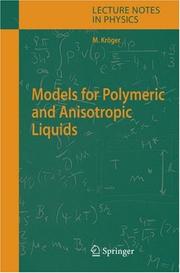| Listing 1 - 3 of 3 |
Sort by
|

ISBN: 9783540262107 3540262105 3540315195 Year: 2005 Publisher: Berlin, Heidelberg : Springer Berlin Heidelberg : Imprint: Springer,
Abstract | Keywords | Export | Availability | Bookmark
 Loading...
Loading...Choose an application
- Reference Manager
- EndNote
- RefWorks (Direct export to RefWorks)
Models should be as simple as possible, but no simpler. For the physics of polymeric liquids, whose relevant lengths and time scales are out of reach for first principles calculations, this means that we have to choose a minimum set of sufficiently detailed descriptors such as architecture (linear, ring, branched), connectivity, semiflexibility, stretchability, excluded volume, and hydrodynamic interaction. These 'universal' fluids allow the prediction of material properties under external flow- or electrodynamic fields, the results being expressed in terms of reference units, specific for any particular chosen material. This book provides an introduction to the kinetic theory and computer simulation methods needed to handle these models and to interpret the results. Also included are a number of sample applications and computer codes.
Polymer solutions --- Crystalline polymers --- Mathematical models. --- Organic Chemistry --- Atomic Physics --- Physics --- Chemistry --- Physical Sciences & Mathematics --- Mathematical models --- Crystal polymers --- Crystallographically ordered polymers --- Polymer crystals --- Liquid polymers --- Polymeric liquids --- Physics. --- Polymers. --- Continuum physics. --- Amorphous substances. --- Complex fluids. --- Continuum mechanics. --- Soft and Granular Matter, Complex Fluids and Microfluidics. --- Polymer Sciences. --- Classical Continuum Physics. --- Numerical and Computational Physics. --- Continuum Mechanics and Mechanics of Materials. --- Mechanics of continua --- Elasticity --- Mechanics, Analytic --- Field theory (Physics) --- Complex liquids --- Fluids, Complex --- Amorphous substances --- Liquids --- Soft condensed matter --- Classical field theory --- Continuum physics --- Continuum mechanics --- Polymere --- Polymeride --- Polymers and polymerization --- Macromolecules --- Natural philosophy --- Philosophy, Natural --- Physical sciences --- Dynamics --- Mechanics. --- Mechanics, Applied. --- Classical and Continuum Physics. --- Numerical and Computational Physics, Simulation. --- Solid Mechanics. --- Applied mechanics --- Engineering, Mechanical --- Engineering mathematics --- Classical mechanics --- Newtonian mechanics --- Quantum theory --- Polymers .
Digital
ISBN: 9783540315193 Year: 2005 Publisher: Berlin Heidelberg Springer-Verlag GmbH
Abstract | Keywords | Export | Availability | Bookmark
 Loading...
Loading...Choose an application
- Reference Manager
- EndNote
- RefWorks (Direct export to RefWorks)
Numerical analysis --- Classical mechanics. Field theory --- Fluid mechanics --- Thermodynamics --- Macromolecules --- Computer. Automation --- thermodynamica --- materie (fysica) --- algoritmen --- mechanica --- polymeren --- fysicochemie --- numerieke analyse --- vloeistoffen
Book
ISBN: 9783540315193 Year: 2005 Publisher: Berlin Heidelberg Springer Berlin Heidelberg
Abstract | Keywords | Export | Availability | Bookmark
 Loading...
Loading...Choose an application
- Reference Manager
- EndNote
- RefWorks (Direct export to RefWorks)
Models should be as simple as possible, but no simpler. For the physics of polymeric liquids, whose relevant lengths and time scales are out of reach for first principles calculations, this means that we have to choose a minimum set of sufficiently detailed descriptors such as architecture (linear, ring, branched), connectivity, semiflexibility, stretchability, excluded volume, and hydrodynamic interaction. These 'universal' fluids allow the prediction of material properties under external flow- or electrodynamic fields, the results being expressed in terms of reference units, specific for any particular chosen material. This book provides an introduction to the kinetic theory and computer simulation methods needed to handle these models and to interpret the results. Also included are a number of sample applications and computer codes.
Numerical analysis --- Classical mechanics. Field theory --- Fluid mechanics --- Thermodynamics --- Macromolecules --- Computer. Automation --- thermodynamica --- materie (fysica) --- algoritmen --- mechanica --- polymeren --- fysicochemie --- numerieke analyse --- vloeistoffen
| Listing 1 - 3 of 3 |
Sort by
|

 Search
Search Feedback
Feedback About UniCat
About UniCat  Help
Help News
News